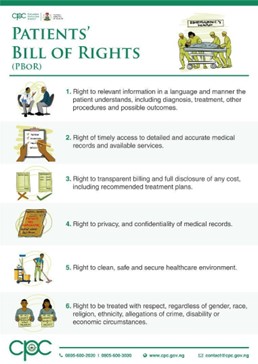The set of rules designed to protect patients who are described as vulnerable are known as?
Doctrine of privileged information.
Collaborative practice.
Patients’ bill of rights.
Nurse practice act.
The Correct Answer is C
The Patients’ bill of rights is a set of rules that protect patients and ensure that they are treated with dignity, respect, and autonomy. It describes the rights that patients have when they receive medical care and treatment. The Patients’ bill of rights was created to protect patients who are vulnerable and may not have the ability or resources to advocate for themselves.
The Doctrine of privileged information refers to the legal concept that certain information shared between a patient and healthcare provider is confidential and cannot be disclosed without the patient’s consent.
Collaborative practice refers to the coordinated efforts of healthcare professionals from different disciplines working together to provide comprehensive and high-quality patient care.
The Nurse practice act is a set of laws that govern the practice of nursing in a specific state or jurisdiction. It outlines the scope of nursing practice and the responsibilities and obligations of nurses.

Nursing Test Bank
Naxlex Comprehensive Predictor Exams
Related Questions
Correct Answer is A
Explanation
As a healthcare provider, it is important to respect and support the cultural and religious practices of our patients. In this case, the patients have expressed a desire to follow the same prayer schedule they did prior to admission, and it is our responsibility to accommodate their request to the best of our abilities.
Option b, suggesting that the patients learn another prayer, may not be appropriate as it implies that their current prayer practices are not valid or important.
Option c, suggesting that they can go back to their regular prayer schedule after discharge, ignores their current needs and may cause unnecessary stress or discomfort.
Option d, dismissing their request and saying "you are in America now" is disrespectful and inappropriate.
Therefore, the best response is a, asking how we can accommodate the patients' prayer time, showing respect for their cultural and religious beliefs and willingness to support their needs.
Correct Answer is A
Explanation
The State nurse practice act outlines the legal scope of practice for nurses in a particular state, including the tasks and procedures that nurses are authorized to perform. Therefore, if the nurse is unsure whether a particular procedure falls within their scope of practice, the State nurse practice act is the best source of information to consult. The nurse should review the act to determine whether they have the necessary knowledge, skills, and authority to perform the procedure safely and legally.
Regional nurse practice acts and community nurse practice acts may provide additional guidance but are not as authoritative as the State nurse practice act.
While Google may provide some information, it is important for the nurse to rely on reliable and authoritative sources of information to ensure safe and effective patient care.
Whether you are a student looking to ace your exams or a practicing nurse seeking to enhance your expertise , our nursing education contents will empower you with the confidence and competence to make a difference in the lives of patients and become a respected leader in the healthcare field.
Visit Naxlex, invest in your future and unlock endless possibilities with our unparalleled nursing education contents today
Report Wrong Answer on the Current Question
Do you disagree with the answer? If yes, what is your expected answer? Explain.
Kindly be descriptive with the issue you are facing.
